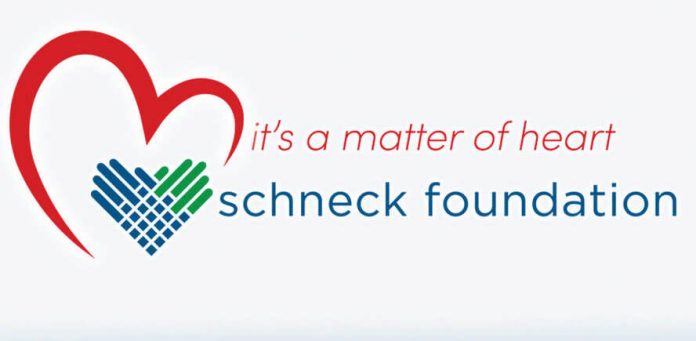
Giving is the heartbeat of the Schneck Foundation.
The primary focus of the not-for-profit organization is to support health-related activities within Schneck Medical Center in Seymour.
A gift to the foundation enables it to improve and expand patient care services, purchase medical equipment upgrades and provide educational programs for the growing community, according to schneckmed.org/foundation.
During the recent fourth annual Giving Tuesday effort, more than $233,000 was raised to support the foundation’s It’s a Matter of Heart Campaign.
Stephanie Flinn, the foundation’s executive director, said matching partners SIHO Insurance Services, MyTruAdvantage and the Schneck team member giving group EPiC matched donations up to the goal of $200,000. Regardless of the date of the donation, the match was applied until the funds were exhausted, she said.
These funds will purchase 13 automated external defibrillators with cabinets for all high schools in Schneck’s service area, which are Austin, Brownstown Central, Crothersville, Eastern, Grace Christian Academy, Jennings County, Medora, Salem, Sandy Creek Christian Academy, Scottsburg, Seymour, Trinity Lutheran and West Washington.
In addition, two LUCAS chest compression devices and at least nine defibrillators for Schneck will be purchased.
“As a team, we celebrate each donation exactly as it is: A gift from the heart,” Flinn said. “It’s the time of year when people buy gifts for those they know and love, and to think they have chosen to support an initiative to help people they may never meet, it’s humbling and represents the true spirit of giving. The foundation feels honored to provide the opportunity to assist in connecting the givers and the receivers to improve health and wellness.”
A campaign video was posted on the foundation’s website in which testimonies were shared by hospital staff and community members about the technology that will be purchased.
The heart-related devices will make an impact, as one in every four deaths in the nation is due to heart disease and there’s one death every 34 seconds.
“Heart disease does not play favorites,” Venetia Green, director of in-patient nursing services/coordinated services, says in the video.
“Even more disturbing, nearly half of all adults in the U.S. have some form of heart disease, and someone has a heart attack every 40 seconds,” Carrie Moore, manager of in-patient med-surg, says. “Half of these are first heart attacks, and one in five is a silent attack, meaning the damage is done without you knowing.”
Critical Care Manager Heather Woods said elevated blood pressure, high cholesterol, smoking and obesity are key risk factors for heart disease.
“Combined with Indiana’s increasing rates of obesity and tobacco use, it significantly increases heart disease in our communities,” she says. “In fact, Indiana ranks 46th in obesity and 45th in smoking and tobacco use.”
Green then emphasizes the need for defibrillators, noting they are one of Schneck’s most critical lifesaving tools and are used every day.
“For those in cardiac arrest, studies show that a patient’s chance of survival is decreased by 10% for every minute that goes by without shock treatment,” Green says.
In the video, the difference between AEDs and medical-grade defibrillators is explained. Moore says the job of both is to deliver an electric current, or shock, to revive an irregular heartbeat during resuscitation.
“AEDs are public access devices. You see them in businesses, churches and even public areas in our medical center. Anyone without formal medical training can use them to assist in heart emergencies,” she says. “AED machines can detect heart arrhythmias on their own or after a sudden cardiac arrest and automatically deliver the electrical current to a patient when the device deems it necessary, telling the untrained user what to do through step-by-step instructions until medical personnel arrives.”
Medical-grade hospital defibrillators are made explicitly for emergencies where trained medical personnel are present, Green says.
“These machines are superior with a broad range of options requiring the knowledge of qualified doctors, nurses and technicians to read the outputs and determine how large of a shock to give the patient and when to administer the shock,” she says.
Another lifesaving measure is a Lund University Cardiopulmonary Assist Device, LUCAS device for short. Woods says it provides mechanical chest compressions by delivering high-quality and consistent fixed-rate compressions.
“It reduces care team fatigue and individual variations from CPR and therefore the need to switch providers every 2 minutes,” she says.
The LUCAS devices will be in Schneck’s critical care unit and emergency department.
Combined, Flinn said these three types of lifesaving devices will provide Schneck’s friends, family and neighbors with the best possible outcomes.
“It’s a matter of heart, and the life of someone you love may depend on it,” she says in the video.
To learn more about the lifesaving technology and the Giving Tuesday effort and to view videos, visit schneckmed.org/giving-tuesday. The foundation may be reached at 812-522-4247.
